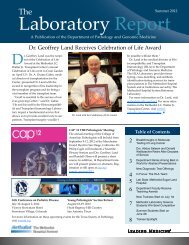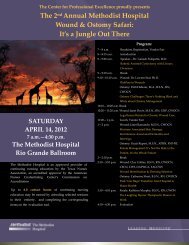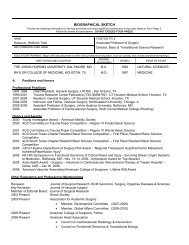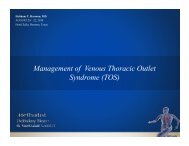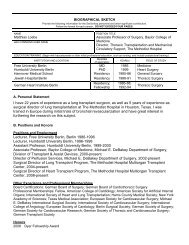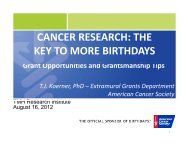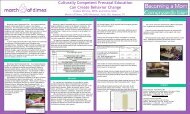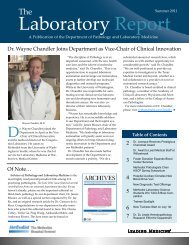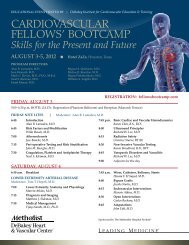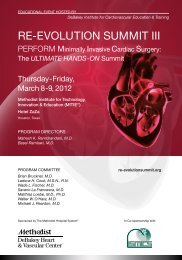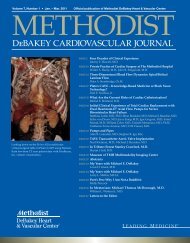The Facts Karla M. Ku - The Methodist Hospital
The Facts Karla M. Ku - The Methodist Hospital
The Facts Karla M. Ku - The Methodist Hospital
You also want an ePaper? Increase the reach of your titles
YUMPU automatically turns print PDFs into web optimized ePapers that Google loves.
PPARa agonists diminishes myocardial<br />
TG accumulation, inhibits production<br />
of inflammatory factors such as tumor<br />
necrosis factor, attenuates cardiac<br />
fibrosis and improves cardiac function. 11<br />
<strong>The</strong>oretically, PPARa activation could<br />
also induce the expression of FA<br />
importing proteins and thus increase FA<br />
uptake from the circulation. <strong>The</strong>refore,<br />
the question of whether PPARa agonists<br />
induce or normalize an imbalance<br />
between the uptake and utilization of<br />
FAs requires further investigation.<br />
<strong>The</strong>re are no reports to date of deteriorating<br />
cardiac function in humans<br />
treated with fibrates — synthetic<br />
PPARa agonists — despite widespread<br />
use to treat hyperlipidemia in patients<br />
with known cardiac disease, suggesting<br />
that PPARa agonists may provide a net<br />
benefit to the cardiovascular system.<br />
C o n C l u s I o n<br />
PPARs transcriptionally regulate<br />
every aspect of fatty acid metabolism.<br />
<strong>The</strong>refore, development of efficient<br />
and targeted PPAR agonists may serve<br />
as a novel strategy to combat heart<br />
disease complicated by myocyte lipid<br />
imbalance.<br />
R e f e R e n C e s<br />
1. Unger RH. Lipotoxic diseases. Annu Rev<br />
Med. 2002;53:319-36.<br />
2. Barger PM, Kelly DP. PPAR signaling<br />
in the control of cardiac energy metabolism.<br />
Trends Cardiovasc Med. 2000<br />
Aug;10(6):238-45.<br />
3. Tian Q, Barger PM. Do PPARs play a role<br />
in cardiac hypertrophy and heart failure?<br />
Drug Discovery Today: Disease Mechanism.<br />
2005;2(1):109-14.<br />
4. Cheng L, Ding G, Qin Q, Huang Y, Lewis<br />
W, He N, et al. Cardiomyocyte-restricted<br />
peroxisome proliferator-activated receptordelta<br />
deletion perturbs myocardial fatty acid<br />
oxidation and leads to cardiomyopathy. Nat<br />
Med. 2004 Nov;10(11):1245-50.<br />
5. Watanabe K, Fujii H, Takahashi T,<br />
Kodama M, Aizawa Y, Ohta Y, et al.<br />
Constitutive regulation of cardiac fatty<br />
acid metabolism through peroxisome proliferator-activated<br />
receptor alpha associated<br />
with age-dependent cardiac toxicity. J Biol<br />
Chem. 2000 Jul;275(29):22293-9.<br />
6. Leone TC, Weinheimer CJ, Kelly DP. A<br />
critical role for the peroxisome proliferatoractivated<br />
receptor alpha (PPARalpha) in<br />
the cellular fasting response: the PPARalpha-null<br />
mouse as a model of fatty acid<br />
oxidation disorders. Proc Natl Acad Sci U<br />
S A. 1999 Jun;96(13):7473-8.<br />
7. Petersen KF, Dufour S, Befroy D, Garcia<br />
R, Shulman GI. Impaired mitochondrial<br />
activity in the insulin-resistant offspring of<br />
patients with type 2 diabetes. N Engl J Med.<br />
2004 Feb;350(7):664-71.<br />
8. Young ME, Guthrie PH, Razeghi P,<br />
Leighton B, Abbasi S, Patil S, et al.<br />
Impaired long-chain fatty acid oxidation<br />
and contractile dysfunction in the<br />
obese Zucker rat heart. Diabetes. 2002<br />
Aug;51(8):2587-95.<br />
9. Zhou YT, Grayburn P, Karim A, Shimabukuro<br />
M, Higa M, Baetens D, et al.<br />
Lipotoxic heart disease in obese rats: implications<br />
for human obesity. Proc Natl Acad<br />
Sci U S A. 2000 Feb;97(4):1784-9.<br />
10. Sack MN, Disch DL, Rockman HA, Kelly<br />
DP. A role for Sp and nuclear receptor transcription<br />
factors in a cardiac hypertrophic<br />
growth program. Proc Natl Acad Sci USA.<br />
1997 Jun;94(12):6438-43.<br />
11. Aasum E, Belke DD, Severson DL,<br />
Riemersma RA, Cooper M, Andreassen M,<br />
et al. Cardiac function and metabolism in<br />
type 2 diabetic mice after treatment with<br />
BM 17.0744, a novel PPAR-alpha activator.<br />
Am J Physiol Heart Circ Physiol. 2002<br />
Sept;283(3):H949-57.<br />
2 II (1) 2006 | JMDHC



